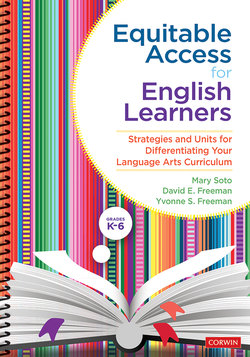Читать книгу Equitable Access for English Learners, Grades K-6 - Mary Soto - Страница 46
На сайте Литреса книга снята с продажи.
2. Cognate and Multilingual Word Walls
ОглавлениеA second translanguaging strategy is to draw on cognates and to make bilingual or multilingual word walls. This strategy helps build a multilingual linguistic ecology and also scaffolds instruction. Of course, there are no cognates if the home language is not related to English. However, about three-fourths of emergent bilinguals are Spanish speakers, and it is estimated that 30–40% of all English words have a related word in Spanish. Further, academic terms in English are often cognates of everyday Spanish words.
Teachers can draw on cognates in different ways. For example, students could be given a text in English and the translation in Spanish. Then, working in pairs, students could identify words that look alike. Next, students could report these words back to the teacher, who could make a chart of all the cognate pairs in the passage. Word walls with cognates based on terms from a unit of study can be posted around the room to serve as a resource for students as they talk, read, and write about the unit.
Standards based skills: compare and contrast, draw on background knowledge
In classes with students who speak languages other than Spanish, the word walls can be expanded to include words from Mandarin, Arabic, or other languages. Multilingual word walls might include words that are not cognates but rather important terms related to the unit. All students are interested in seeing how their classmates write and pronounce words in their home language.
Standards based skills: draw on background knowledge, compare English and other languages
